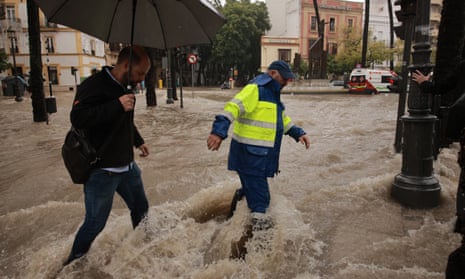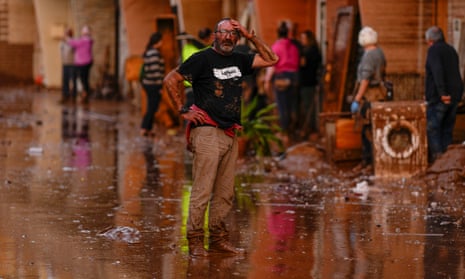Key events Show key events only Please turn on JavaScript to use this feature
Here are some of the latest images from affected areas in Spain:



‘We were trapped like rats’: floods bring devastation and despair
Sam Jones
The gratitude that greeted Tuesday’s dawn downpours was short-lived in Utiel. When the longed-for rains finally reached the town in the drought-stricken eastern Spanish region of Valencia, they were merciless in their abundance.
“People were very happy at first because they’d been praying for rain as their lands needed water,” said Remedios, who owns a bar in Utiel. “But by 12 o’clock, this storm had really hit and we were all pretty terrified.”
Trapped in the bar, she and a handful of her customers could only sit and watch as Spain’s worst flooding in almost 30 years caused the Magro River to overflow its banks, trapping some residents in their homes and sending cars and rubbish bins surging through the streets on muddy flood waters.
“The rising waters brought mud and stones with them and they were so strong that they broke the surface of the road,” said Remedios, who gave only her first name.
“The tunnel that leads into the town was half-full of mud, trees were down and there were cars and rubbish containers rolling down the streets. My outside terrace has been destroyed – the chairs and shades were all swept away. It’s just a disaster.”
By Wednesday afternoon, the death toll in Valencia and the neighbouring regions of Castilla-La Mancha and Andalucía stood at 95 . Utiel’s mayor, Ricardo Gabaldón, told Las Provincias newspaper that some of the town’s residents had not survived the floods, but was unable to provide an exact number.
Hours earlier, Gabaldón had told Spain’s national broadcaster, RTVE, that Tuesday had been the worst day of his life. “We were trapped like rats,” he said. “Cars and rubbish containers were flowing down the streets. The water was rising to 3 metres.”
Rescue personnel and more than 1,100 soldiers from Spain’s emergency response units have been deployed to affected areas. Spain’s central government has also set up a crisis committee to coordinate rescue efforts.
As the search for missing people continues, motorists are urged to stay off the roads and away from swollen rivers amid warnings that the severe weather was not over and that the number of deaths could still rise.
Search for survivors continues as more rain forecast
Rescue workers in Spain continued to search for more victims after deadly floods, as questions were raised about how one of the world’s most developed nations failed to respond adequately to an extreme storm.
Torrential rains that began at the start of the week sparked flooding that has left at least 95 people dead, the deadliest such disaster in the western European country since 1973.
Defence minister Margarita Robles told Cadena Ser radio station that a military unit specialised in rescue operations would on Thursday start combing through the mud and debris with sniffer dogs in the worst-hit areas.
Asked if the number of victims was likely to increase, she said: “Unfortunately we are not optimistic”.
The teams have brought with them 50 mobile morgues.
More heavy rain was predicted for the hardest-hit eastern Valencia region and other areas on the north-east coast on today.

 3 weeks ago
3 weeks ago


















